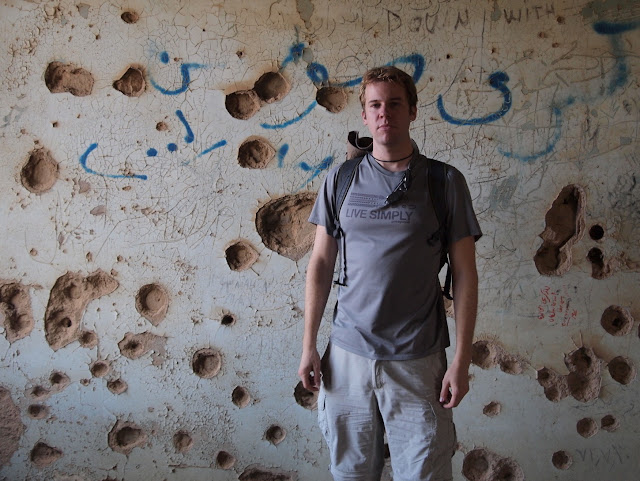I drove away from the Druze village of Majdal Shams and turned on to a lonely highway headed south. A military convoy sped past in the opposite direction. The Israeli army had been a constant presence since my arrival in the country two weeks ago, even more so since I'd crossed into this disputed region. Something suddenly caught my eye up ahead. I pulled over the car and stepped out into the fierce winds of the Golan Heights. In front of me was the detached turret of an old tank, laying right alongside the road. The massive gun was aimed at a ruined city located a little over a mile away. I realized with a startle that not long ago I had been walking amongst those very ruins, in the target of this menacing weapon and across a contentious border. As if in confirmation, I caught sight of the red and black-striped flag of Syria, waving defiantly in the distance.


Eighteen months prior, four months before the beginning of an uprising that would eventually consume an entire nation, I had been an Arabic student at the University of Damascus. Through some other students I found out about the destroyed city of Quneitra, forty miles to the southwest of the Syrian capital. The Syrian authorities allowed foreigners to visit the site and it was worth the effort, I was told.
A few days later, I arose early and hopped into a taxi. The first stop was the Ministry of Interior in Damascus, where I needed to apply for permission to visit the site. A young German woman had beat me there and was already in line to receive her permit. A short time later we were both crammed into a minibus, heading towards our destination.
 |
| Entrance to Quneitra, Syria |
We hopped out of the bus and walked towards the military post that guarded the entrance to the deserted city. A soldier greeted us impassively and asked to see our permits. Satisfied, he introduced us to our plainclothes-wearing guide. The guide spoke very little English. But this would not matter. Mere words would pale in comparison to the sheer visual impact of what we were about to see.
 |
| Road into Quneitra. Flattened houses line both sides of the street. |
When the modern states of Syria and Israel gained independence after the Second World War, the Syrian city of Quneitra became an important trading and military post. Just 40 miles from the then-Israeli border, the city's population expanded to over 20,000 people. During the 1967 Arab-Israeli conflict, Quneitra was captured by Israel. They held the strategically located city for much of the next seven years. A 1974 disengagement agreement returned Quneitra to Syria. But the pile of rubble and concrete shell that Syria then received bared little resemblance to its former self.

 |
| The rubble of an imploded building buried under its roof |
Much of the city had been heavily damaged by conflict during and after the 1967 war. In fact, a sizable amount of destruction had been ravaged upon Quneitra by Syria itself, as they shelled the Israeli-occupied city in the early 1970's, eventually leading to a brief recapture in 1973. But there is little doubt that immediately prior to the 1974 Israeli withdrawal, the soon-to-depart forces systematically razed much of the city. Few buildings were left standing as Quneitra was leveled with bulldozers and dynamite. Structures still upright were torn apart by artillery rounds and looted of anything of value.
Instead of attempting to reconstruct a completely decimated city, Syria built the town of New Quneitra nearby. The original city was left untouched and abandoned in order to serve as both a memorial and, equally likely, an effective piece of anti-Israel propaganda.
The cultivated fields and dry hills of the Israel-controlled portion of the Golan Heights are clearly visible from the ruins of Quneitra. I remember staring up at the cars driving on the highway that sliced through the large hill in the distance, and wondering what it was like on that side of the border. Little did I know then that in eighteen months time I'd be standing up there, gazing down at my current location from the barrel of a tank.
 |
| Flattened houses in Quneitra. The hill in the distance is where I'd observe the ruins from 18 mos. later. |
The most haunting site we visited in Quneitra was a ruined hospital. The former place of healing had been transformed into a shocking testament to violence. Entire interior walls had been blown apart. Halls were filled ankle deep with rubble. Tiled rooms intended to hold patients were strewn with bullet holes. It was as if the best instinct of humanity had fought a pitched battle with its dark side and lost.
As I recall the eerie feeling of walking through a Syrian ghost town devastated by war, I can't help but draw associations to the present. Is this what many places in Syria look like now? How many hospitals, how many schools, how many homes have been destroyed, not by invading forces but by Syrians themselves? How many people did I come across and friends did I make that have been violently drawn into the civil war raging throughout the country? And just how long will the circle of bloodshed last?
There is no way to know the answer to those questions, and there never may be. Foreigners may not be able to visit Syria again for a long time. And by then, it will surely be a very different place than it was before. One can only hope that the desolate scene of Quneitra will have been more exception than rule in a land so important to the history of human civilization. And hope that one day, Syrians will find a way to move past the scars of the past in order to create a more peaceful future.
*******












No comments :
Post a Comment